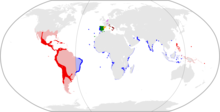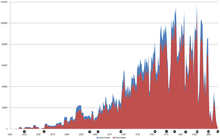A century after Columbus' first voyage large parts of the New World had been included into the
Spanish Empire
Christopher Columbus discovered the Americas in 1492 under Spanish flag.
[67] Six years later
Vasco da Gama reached India under Portuguese flag, by navigating south around the
Cape of Good Hope, thus proving that the Atlantic and Indian Oceans are connected. In 1500, in his voyage to India following Vasco da Gama,
Pedro Alvares Cabral reached Brazil, taken by the currents of the
South Atlantic Gyre. Following these explorations, Spain and Portugal quickly
conquered and colonized
large territories in the New World and forced the Native American
population into slavery in order to explore the vast quantities of
silver and gold they found. Spain and Portugal monopolised this trade in
order to keep other European nations out, but conflicting interests
nevertheless lead to a series of Spanish-Portuguese wars. A peace treaty
mediated by the Pope divided the conquered territories into Spanish and
Portuguese sectors while keeping other colonial powers away. England,
France, and the Dutch Republic enviously watched the Spanish and
Portuguese wealth grow and allied themselves with
pirates such as
Henry Mainwaring and
Alexandre Exquemelin.
They could explore the convoys leaving America because prevailing winds
and currents made the transport of heavy metals slow and predictable.
[67]
Embarked and disembarked slaves in the
Atlantic slave trade 1525–1863 (first and last slave voyages)
In the American colonies depredation, disease, and slavery quickly reduced the
indigenous American population to the extent that the
Atlantic slave trade
had to be introduced to replace them — a trade that became norm and an
integral part of the colonisation. Between the 15th century and 1888,
when
Brazil
became the last part of America to end slave trade, an estimated ten
million Africans were exported as slaves, most of them destined for
agricultural labour. The slave trade was officially abolished in the
British Empire and the
United States in 1808, and slavery itself was abolished in the British Empire in 1838 and in the U.S. in 1865 after the
Civil War.
[68][69]
From Columbus to the
Industrial Revolution
Trans-Atlantic trade, including colonialism and slavery, became crucial
for Western Europe. For European countries with a direct access to the
Atlantic (including Britain, France, the Netherlands, Portugal, and
Spain) 1500–1800 was a period of sustained growth during which these
countries grew richer than those in Eastern Europe and Asia. Colonialism
evolved as part of the Trans-Atlantic trade, but this trade also
strengthened the position of merchant groups at the expense of monarchs.
Growth was more rapid in non-absolutist countries, such as Britain and
the Netherlands, and more limited in
absolutist monarchies, such as Portugal, Spain, and France, where profit mostly or exclusively benefited the monarchy and its allies.
[70]
Trans-Atlantic trade also resulted in an increasing
urbanisation:
in European countries facing the Atlantic urbanisation grew from 8% in
1300, 10.1% in 1500, to 24.5% in 1850; in other European countries from
10% in 1300, 11.4% in 1500, to 17% in 1850. Likewise,
GDP
doubled in Atlantic countries but rose by only 30% in the rest of
Europe. By end of the 17th century the volume of the Trans-Atlantic
trade had surpassed that of the Mediterranean trade.
[70]


No comments:
Post a Comment